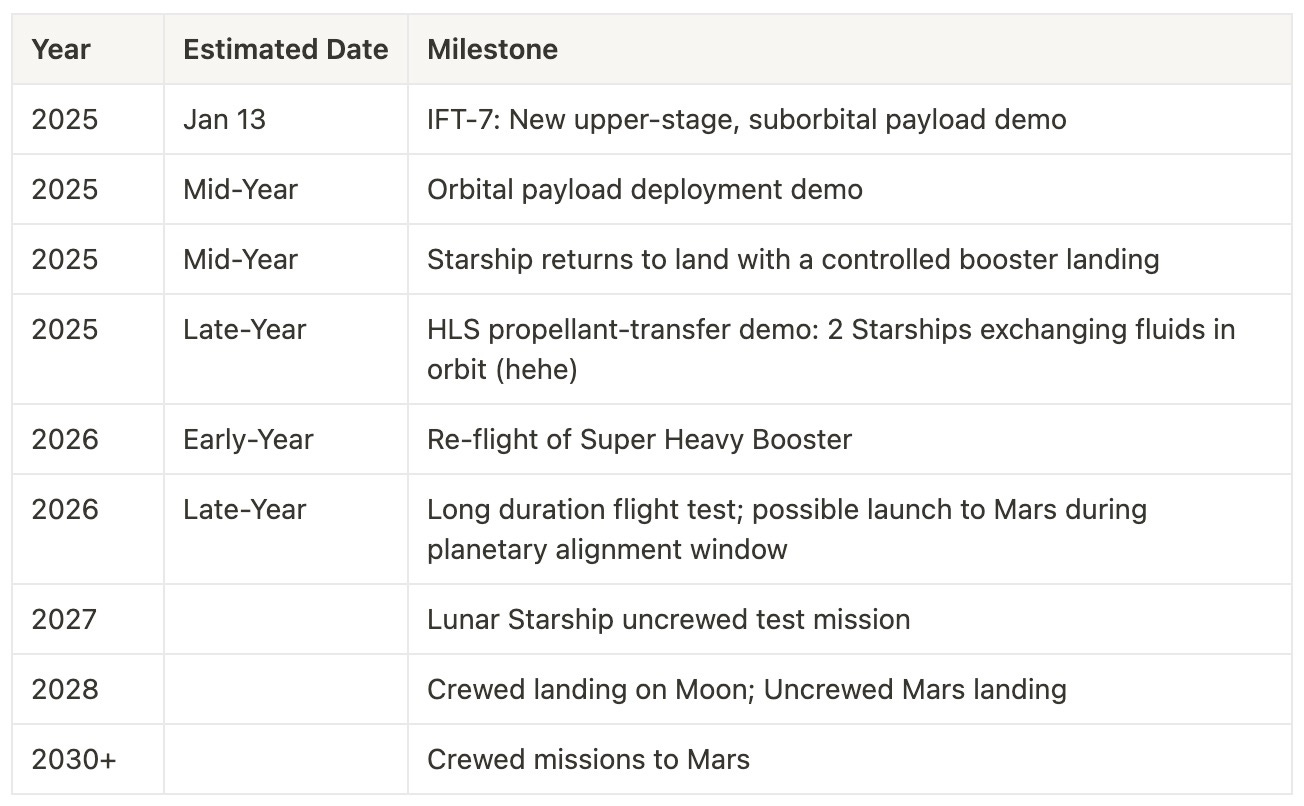Catching Giants
What's next for SpaceX's Starship after the booster catch?
On October 13, 2024, SpaceX launched their fifth test flight of Starship, the largest rocket ever flown. The larger booster section returned to land and was caught by the tower with giant mechanical arms.
News of the catch went viral. More people are finally starting to pay attention to Starship after October’s launch and catch of the superheavy booster. If you somehow missed it — watch this highlight reel to catch up. Eric Berger wrote about the implications here as well.
For the booster, returning it in one piece is the hard part. This was the single biggest obstacle to the entire Starship concept.
This is why the catch was such a big deal. Someday soon, it will be launched, caught, refueled, and sent back up quickly and often.
So what?
Here’s a recap of what’s happened so far:
Starship has now been proven to be capable of:
Getting to orbit (roughly).
Returning Super Heavy booster.
Sub-orbital reentry of Starship upper-stage with precise splashdown landing.
Live video from nearly the entire flight. (Not critical, but I think it’s awesome enough to include as it’s the first ever live video during reentry.)
Re-entry for an orbital ship is really hard. It’s currently done with capsules like Dragon, Starliner and others. The bottoms have thick tiles to absorb the massive amount of frictional heat produced. The Space Shuttle did this, but even then they had multiple failures, including the tragic loss of Columbia in 2003.
But let’s ignore the upper-stage for now as it may take years to nail down resuse. Soon it will be possible to reuse the booster. This is already monumental for a few reasons.
First, cost.
Estimated cost for a full Starship stack currently is $90-100M. This is already 10x cheaper than other large cost-plus rockets. At a payload of 100 tons, this would be $1,000 per kg if Starship is fully expendable (no reusability). Here’s a chart of launch costs to LEO. Pretty damn good! It would be the cheapest way to get to space, just under Falcon Heavy. And as scale increases, costs will come down further, maybe as low as $50M.
The booster cost is now around $40-50M. SpaceX may start reusing it in a year from now. If they can reuse the booster 5 times with $2M refurb each time, it brings cost down to ~$600/kg. You can see that with conservative assumptions, cost is already very low.
Cost ultimately matters most, but it’s not everything. Other game changing benefits of Starship are:
Launch frequency: SpaceX currently has capacity to build at least 25 ships a year. The plan is to eventually get it to one per day. They’re not even in full production mode and still CRANKING them out compared to other big rockets. When makers of space hardware can assume that they’ll be easily able to launch more than once per month it changes what you can build.
Size: The total volume of 100-150 tons is significantly more than any other rocket. So you can just get more stuff into space in a single launch. More than that though — the volume is much larger. The James Webb Space Telescope cost $10 billion to make, and a lot of the complexity was because they had to origami it into ~200 cubic meters of space. Starship volume is 5x this. If the next big telescope is launched on Starship, it can be both much bigger and much cheaper. Scientists should be rethinking their future plans.
Starship’s significance lies in its potential to make space travel dramatically cheaper, faster, and more sustainable. It could enable massive payloads, in-orbit refueling, and rapid reuse, paving the way for lunar bases, Mars colonization, and humanity’s expansion into the solar system. Beyond the technical achievements, it represents a profound shift in what humanity is capable of.
What’s next?
The key here is iteration speed. Each integrated flight test (IFT) pushes Starship to its limit in one or more ways. This maximizes learning not only for the rocket design itself, but for the entire Starship system — launch pad infrastructure, ground control, propellant systems, and manufacturing.
To take full advantage of Starship (on the Moon, Mars, or beyond), it has to be refueled many times in orbit. Critics say these refueling missions are tricky, but it might not be if launches get cheaper and more common.
Even as Starship starts delivering actual payloads, production volume becomes critical. The more it launches, the cheaper it gets. Needing 12 launches for every trip to the Moon seems daunting until you consider their goal of averaging a launch per day.
Mass production is not something the space industry has ever needed. Building “the machine that builds the machine” is exactly what’s going in in Starbase, Texas right now.

Finally we’ll have a rocket that's treated like a commercial airliner, that can depart and land multiple times every day, with the only limit being maintenance.
But just a reminder: this shit is hard. And it’s not just the engineering of the rocket itself. For example, each launch requires an insane amount of fuel and liquid oxygen. From Eric Berger:
Put another way, launching four Starship rockets in a single day would consume all of the nation’s liquid oxygen capacity for that day. Accordingly, SpaceX must find a way to scale production of liquid oxygen, and ensure a tremendous supply to both South Texas and its future Starship launch facilities in Florida.
That’s what happens though when you push the boundaries of frontiers. You end up having to solve problems in a lot of areas.
In the next few years, SpaceX wants to show they can restart engines in space, land Starship safely back on land or a tower, transfer fuel between ships, and eventually reuse all parts. If they succeed, humans could land on the Moon again, maybe in 2028, and later reach Mars, thanks to Starship’s massive size and quick turnaround.
Here’s the next milestones and their estimated times (via Eric Berger and others):
NASA’s future role
In other exciting news: Jared Isaacman has been chosen to lead NASA during the Trump administration. Isaacman is the billionaire founder of payments company Shift4. He’s also a jet pilot, astronaut, and first private citizen to perform a spacewalk (just this past September if you missed it).
He is yet to be confirmed but insiders seem confident it will happen. Isaacman has earned respect in the space community for his leadership, commitment, and bold vision for the future of space exploration.
As NASA administrator, he’s expected to push for modernization, focusing on cutting wasteful programs like the SLS rocket and prioritizing collaborations with private companies to advance space exploration efficiently and competitively.
I’m really hopeful here that Isaacman makes NASA much more of a lean organization, capable of spending their irreplaceable taxpayer dollars on exploration and science that truly matters rather than just jobs programs.
Next flight: IFT-7, currently planned for Monday 1/13
The next test flight could launch this Monday. Here’s a list of what they’re testing:
Payload Deployment. Deploying 10 Starlink simulators in a suborbital trajectory, testing deployment systems. This is the first time Starship will attempt to deploy a payload.
New Upper Stage Design. Redesigned flaps (smaller and repositioned), increased propellant capacity, vacuum-insulated feedlines, backup heat shield layer, improved avionics, and metallic tiles with active cooling. A significant number of tiles have been intentionally removed to stress-test vulnerable areas and assess the vehicle's thermal and structural limits during reentry. More cameras have been added as well, with 120Mbps of high-def video sent down during entire flight.
Reusing Booster Hardware. First reuse of a flight-proven Raptor engine. Eventually the whole thing will be reused so they’re starting with a single engine.
Testing Catch Systems. Upgraded chopstick radar sensors, and improved tower protections.
Once again, the goal is to push it to the limit, testing different capabilities. In some cases, the tests will be “to failure”, meaning it is expected for things to break. Imagine how useful it would have been for the Space Shuttle to try a handful of launches with heat shield tiles intentionally removed to test where failure points were.
Make sure to watch the test — currently schedule for Monday at 5pm ET, 2pm PT.
BONUS: Blue Origin’s New Glenn launch on Sunday
Blue Origin’s New Glenn rocket, originally scheduled to launch this morning, is now expected to launch on Sunday 1/12. This will be its first launch.
New Glenn is a (yet to be proven) reusable rocket with a payload capacity up to 45 tons, about double Falcon 9. So it’s a heavy-lift rocket with potentially much more capability than Falcon 9, but still significantly less than Starship.
This is great news! SpaceX has been so far in the lead in recent years, it will be good to have the promise of a little bit of actual competition.






